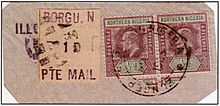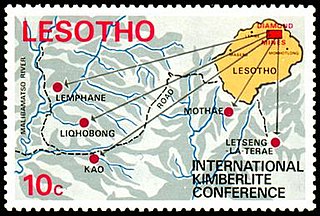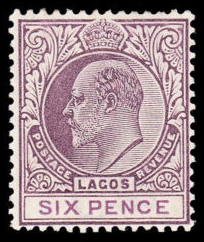
This is a survey of the postage stamps and postal history of the Northern Nigeria Protectorate .

This is a survey of the postage stamps and postal history of the Northern Nigeria Protectorate .
Postage stamps were issued specifically for the Northern Nigeria Protectorate beginning in 1900. [1] All stamps of the Northern Nigeria Protectorate are definitive issues of a Key Plate design, differing in the sovereign depicted, type of paper, watermarks, and choice of colored or colorless numerals for the denomination.
The first series consisted of nine stamps with values ranging from 1/2 pence to 10 shillings, depicting Queen Victoria. The second series, consisting of identical denominations, but in slightly different colors was issued on July 1, 1902, depicting King Edward VII. Unusually, a £25 stamp was issued in April 1904. This was really intended as a revenue stamp, it being nearly impossible to invent a piece of mail needing so much postage. It was used to pay for imported liquor licences. It is the great rarity of philately with copies commanding a high price. The King Edward series was reissued in 1905 in eight denominations, and again in 1910–11 in eleven denominations.
The final series of stamps for the Northern Nigeria Protectorate was a series of thirteen denominations depicting King George V.
Stamps of Northern Nigeria were replaced by those of the Colony and Protectorate of Nigeria in 1914.

A local post briefly existed at Borgu in 1905 for which crudely made one penny stamps were produced. [2]
East Africa and Uganda Protectorates was the name used by the combined postal service of the British protectorates, British East Africa and Uganda, between 1 April 1903 and 22 July 1920.

The postal and philatelic history of Canada concerns postage of the territories which have formed Canada. Before Canadian confederation, the colonies of British Columbia and Vancouver Island, Prince Edward Island, Nova Scotia, New Brunswick and Newfoundland issued stamps in their own names. The postal history falls into four major periods: French control (1604–1763), British control (1763–1841), colonial government control (1841–1867), and Canada, since 1867.

The British Central Africa Protectorate existed in the area of present-day Malawi between 1891 and 1907.

This is a survey of the postage stamps and postal history of the Gilbert and Ellice Islands.
This is a survey of the postage stamps and postal history of Bechuanaland Protectorate.
This is a survey of the postage stamps and postal history of the Niger Coast Protectorate.

Aden is a city in southern Yemen. Aden's location made it a popular exchange port for mail passing between places around the Indian Ocean and Europe. When Captain S. B. Haines of the Indian Marine, the East India Company's navy, occupied Aden on 19 January 1839, mail services were immediately established in the settlement with a complement of two postal clerks and four letter carriers. An interim postmaster was appointed as early as June 1839. Mail is known to exist from 15 June 1839 although a regular postmaster was not appointed until 1857; one of the officials of the Political Agent or the civil surgeon performed the duties of postmaster for a small salary.

The postal history of Malta began in the early modern period, when pre-adhesive mail was delivered to foreign destinations by privately owned ships for a fee. The earliest known letter from Malta, sent during the rule of the Order of St John, is dated 1532. The first formal postal service on the islands was established by the Order in 1708, with the post office being located at the Casa del Commun Tesoro in Valletta. The first postal markings on mail appeared later on in the 18th century.

This is a survey of the postage stamps and postal history of the Southern Nigeria Protectorate.
The Federation of Rhodesia and Nyasaland, also known as the Central African Federation (CAF), was a semi-independent state in southern Africa that existed from 1953 to the end of 1963.
Belize started as the colony of British Honduras, formally established in the 17th century but disputed through the 18th century.

This is a survey of the postage stamps and postal history of Lesotho, formerly known as Basutoland.
This is a survey of the postage stamps and postal history of Nigeria.

This is a survey of the postage stamps and postal history of Lagos, now part of modern Nigeria.

This is a survey of the postage stamps and postal history of Zambia, formerly known as Northern Rhodesia.

This is a survey of the postage stamps and postal history of Zimbabwe.

The Cayman Islands, a British Overseas Territory located in the western Caribbean Sea, came under British control in 1670, as a dependency of Jamaica, continuing in that status until 1962.

The Halfpenny Yellow is the first postage stamp issued by the Crown Colony of Malta. Depicting Queen Victoria, it was only valid for local postage and it was originally issued on 1 December 1860. It was the only stamp issued by Malta for two and a half decades, and during this period various reprints were made with differences in colour shade, perforation and watermark. When control of Malta's postal service was transferred to the island's colonial government on 1 January 1885, the stamp was withdrawn and it was replaced by a set of definitive stamps.
Few revenue stamps of Nigeria and its predecessor states have been issued, since most of the time dual-purpose postage and revenue stamps were used for fiscal purposes. The first revenue-only stamps were consular stamps of the Niger Coast Protectorate and the Southern Nigeria Protectorate, which were created by overprinting postage stamps in 1898 and 1902 respectively. The Northern Nigeria Protectorate did not issue any specific revenue stamps, but a £25 stamp of 1904 could not be used for postal purposes due to its extremely high face value.

Revenue stamps of the Leeward Islands were issued by the British Leeward Islands between 1882 and the 1930s. They were used on Antigua, the British Virgin Islands, Dominica, Montserrat and Saint Kitts and Nevis, all of which also issued their own revenue stamps before, during or after they used common issues for the Leeward Islands.